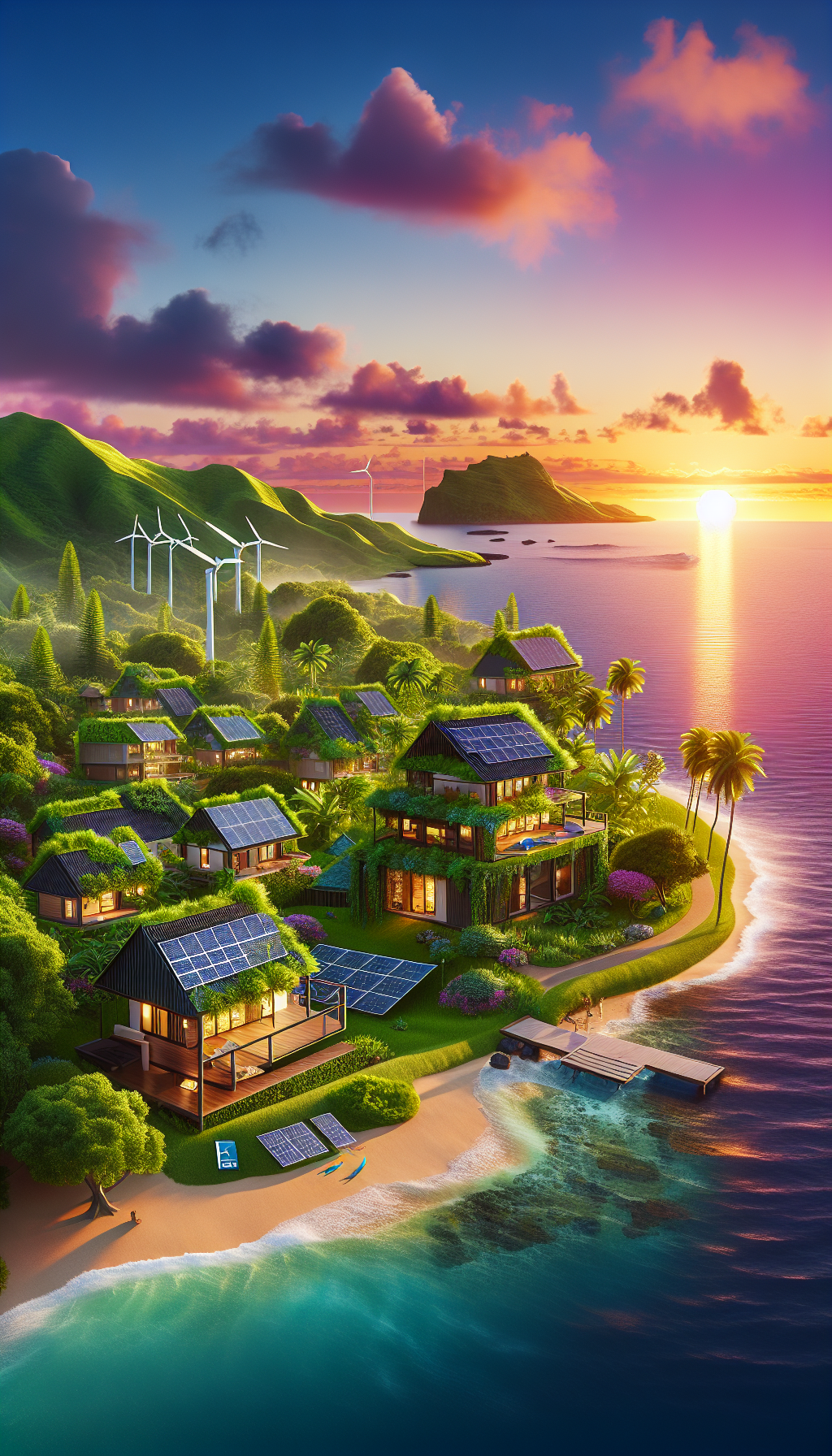Hawaiian Island Development: Sustainable Living and Eco-Friendly Homes
The Essence of Sustainability in Hawaii
Hawaii, known for its stunning natural beauty and rich cultural heritage, faces unique challenges in sustainable living due to its isolation and ecosystem fragility. As development continues to grow, the emphasis on sustainable practices in housing has become paramount. Sustainable living on the Hawaiian Islands integrates environmentally friendly practices that protect the unique biodiversity and vibrant cultures of the islands.
Key Principles of Sustainable Development
Sustainable living in Hawaii revolves around three core principles: environmental preservation, economic viability, and social equity. This triad ensures that development meets the current needs of the community without compromising the resources available for future generations.
-
Environmental Preservation
- Biodiversity Conservation: Hawaii is home to over 25% of the U.S. endangered species. Sustainable housing developers focus on minimizing their impact on native flora and fauna. Efforts include habitat restoration and creating wildlife corridors to protect local ecosystems.
-
Economic Viability
- Local Materials: Promoting the use of locally sourced materials not only supports the economy but also reduces carbon footprints associated with transportation. Developers are increasingly incorporating materials like bamboo, native woods, and recycled resources into their builds.
-
Social Equity
- Affordable Housing Initiatives: Ensuring that eco-friendly homes are accessible to all income levels is critical. Government policies and community programs aim to create affordable, sustainable housing options, allowing Hawaiian communities to thrive.
Eco-Friendly Building Practices
The architecture of eco-friendly homes in Hawaii reflects a commitment to sustainability through design innovations and technology. Here are several building practices that foster sustainable living:
-
Passive Design
- Utilizing the island’s climate, architects are designing homes that capitalize on natural ventilation and lighting. Large windows, overhangs, and strategic landscaping allow for cooling breezes and maximum sunlight, reducing reliance on energy-consuming cooling systems.
-
Green Roofs and Walls
- Integrating vegetation into roofs and walls helps with insulation, reduces water runoff, and promotes biodiversity. These living structures also contribute to local food production and create habitats for wildlife.
-
Solar Power Integration
- Hawaii has set ambitious goals for renewable energy, aiming for 100% renewable energy by 2045. Many new developments incorporate solar panels to harness abundant sunlight, significantly reducing reliance on fossil fuels.
-
Rainwater Harvesting
- Systems designed to collect and utilize rainwater help mitigate water scarcity issues, especially during dry spells. This practice lowers dependence on municipal water supplies and promotes responsible water management.
-
Energy Efficiency
- Low-flow fixtures, LED lighting, and energy-efficient appliances are standard features in eco-friendly homes. These installations lower utility bills and lessen environmental impact by reducing resource consumption.
Community Integration and Resilience
Sustainable living extends beyond individual homes and into community practices. Encouraging resilient communities plays a vital role in Hawaii’s unique context:
-
Civic Engagement
- Communities are increasingly mobilizing to advocate for sustainable practices. Initiatives such as community gardens, local farmers’ markets, and educational programs foster environmental stewardship and strengthen community ties.
-
Cultural Preservation
- Sustainable development respects and integrates native Hawaiian culture and traditions. Developers are learning from the practices of native Hawaiians, such as ‘Ākau and ‘Waena,’ which emphasize living in harmony with nature.
-
Emergency Preparedness
- With Hawaii prone to natural disasters, eco-friendly homes are often designed with resilience in mind. Features include raised foundations, reinforced structures, and landscaping that mitigates the risk of erosion and flooding.
Technological Innovations
Advancements in technology are pivotal to enhancing sustainability in Hawaiian developments:
-
Smart Home Technology
- Smart thermostats, energy management systems, and automated irrigation reduce energy and water usage. Homeowners can monitor their consumption in real-time, making adjustments to save resources.
-
Building Information Modeling (BIM)
- BIM technology allows architects and builders to visualize and simulate projects before they are constructed. This approach identifies potential issues early in the design process, optimizing resource efficiency and minimizing waste.
-
3D Printing
- Innovative building methods like 3D printing are becoming viable options for constructing sustainable homes. These techniques lower labor and material costs while reducing waste generated during the construction process.
Policies Encouraging Sustainable Development
Although the Hawaiian government has made strides in promoting sustainable living, ongoing legislation and policy reforms are essential:
-
Incentives for Green Building
- Tax credits and rebates for solar installation and energy-efficient appliances encourage residents and developers to pursue sustainability. Programs like the Hawaii Green Energy Market Securitization (GEMS) make financing easier for renewable energy projects.
-
Zoning Regulations
- Adapting zoning laws to support mixed-use developments enables walkable communities where residents can access services and amenities without relying solely on vehicles. This reduces emissions and fosters a sense of community.
-
Conservation Easements
- Protecting critical habitats and landscapes is a vital component of policy making. Conservation easements allow landowners to preserve natural spaces, ensuring that new developments do not encroach on essential ecosystems.
The Future of Sustainable Living in Hawaii
The sustainable development movement in Hawaii represents a growing awareness of the need to balance economic growth with environmental stewardship. Educational programs in high schools and universities are training the next generation of architects, builders, and community leaders who are passionate about sustainable practices.
Innovative partnerships among local governments, non-profit organizations, and the private sector are essential to achieving Hawaii’s sustainability goals. By fostering collaboration, sharing best practices, and engaging residents, Hawaii can serve as a model for sustainable living globally.
As Hawaiian Islands continue to develop and adapt to changing circumstances, eco-friendly homes and sustainable living practices will become central to preserving the islands’ natural beauty, culture, and community well-being for generations to come.

